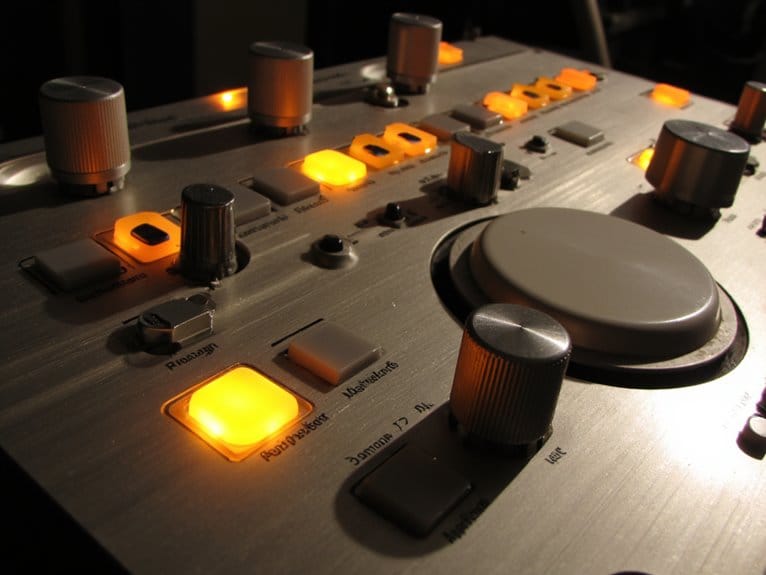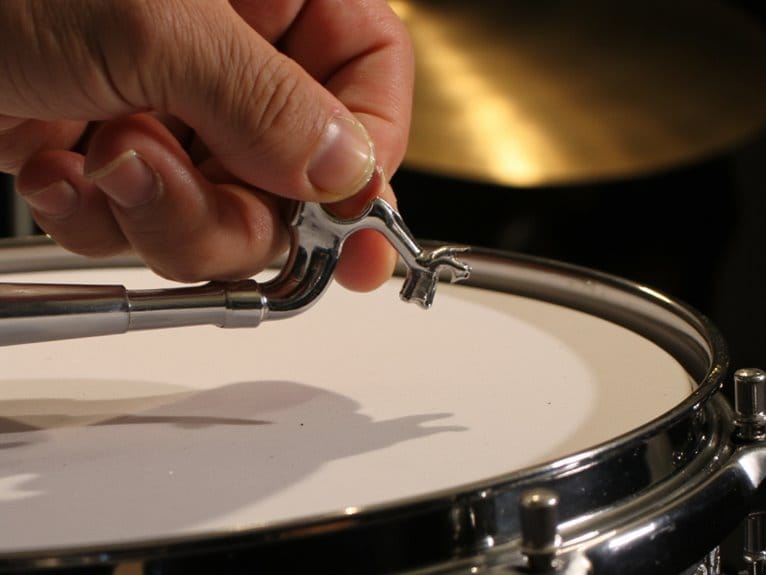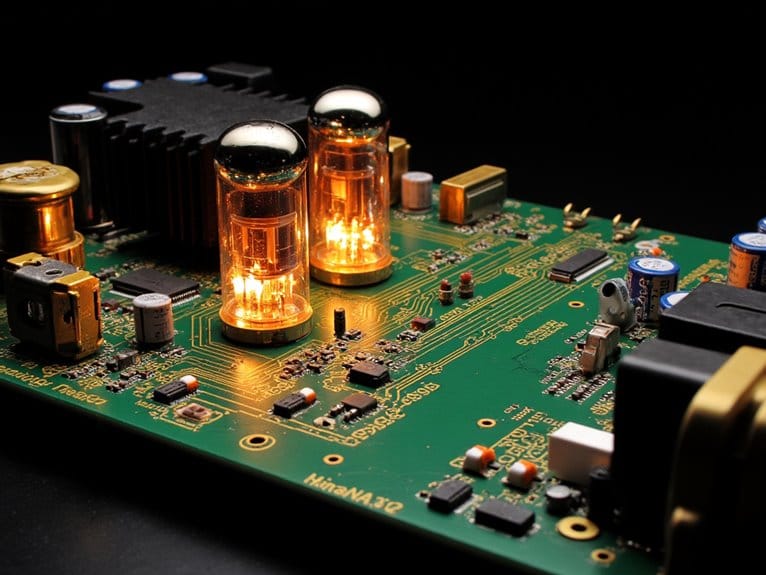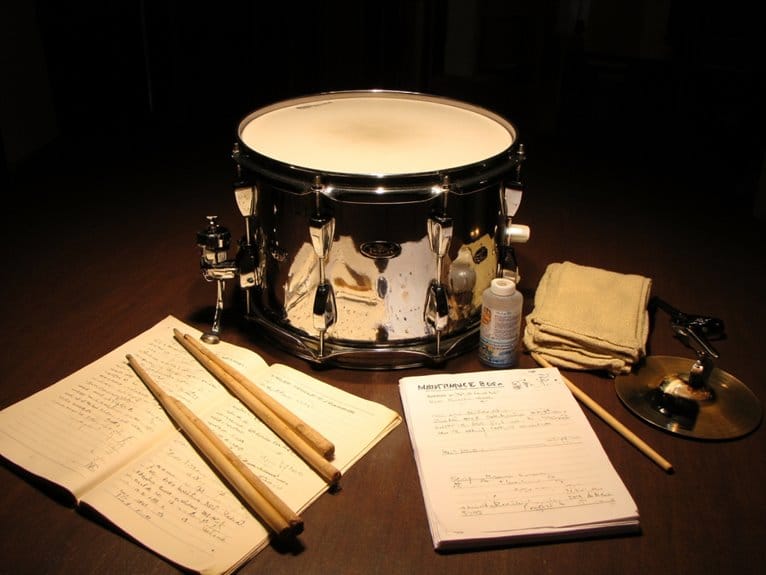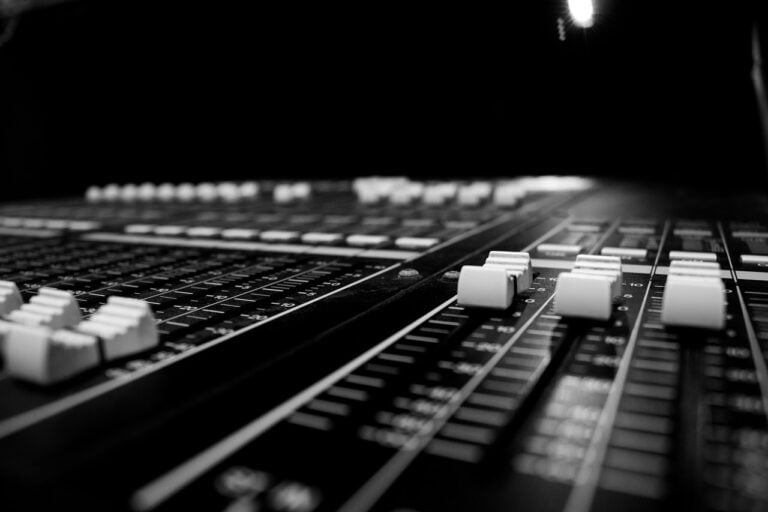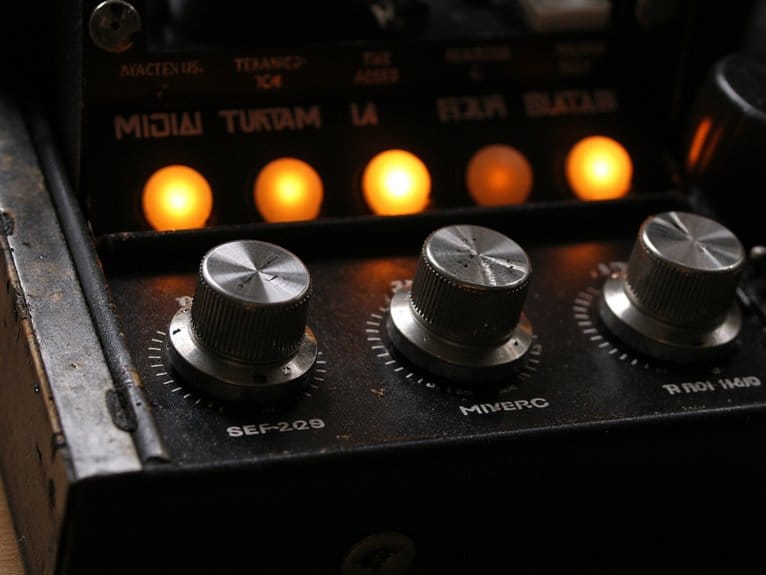Understanding Drum Machines and Rhythm Synthesizers
You’ll find that drum machines and rhythm synthesizers blend percussion programming with sound synthesis, offering everything from classic analog warmth to modern sample-based realism. These devices feature grid-based interfaces with velocity-sensitive pads, programmable sequencers, and real-time parameter control that lets you craft everything from simple 4/4 beats to complex polyrhythmic patterns. Whether you’re using hybrid synthesis engines or pure sampling technology, understanding their evolution from 1970s preset boxes to today’s modular powerhouses will reveal their creative potential.
We are supported by our audience. When you purchase through links on our site, we may earn an affiliate commission, at no extra cost for you. Learn more.
Notable Insights
- Drum machines generate rhythmic sounds through analog synthesis, digital sampling, or hybrid methods combining both technologies.
- Grid-based interfaces with velocity-sensitive pads allow intuitive programming and real-time triggering of drum sounds.
- Modern devices feature advanced sequencing with polyrhythm capabilities, probability controls, and modulation matrices for dynamic patterns.
- Evolution spans from 1949 tape-loop systems to today’s multi-layered synthesis engines with extensive sonic flexibility.
- Contemporary models integrate hardware and software for portable rhythm creation with sampling, synthesis, and effects processing.
Core Functionality and Design Principles
The modern drum machine represents a fascinating evolution from the simple rhythm boxes of the past, transforming into sophisticated instruments that blur the lines between percussion, synthesis, and creative expression.
Today’s designs center on optimizing your control over rhythm creation, balancing preset patterns with custom programmability that I’ve found essential for workflow efficiency.
Modular integration has revolutionized these systems, enabling you to layer rhythmic textures through simultaneous synthesis methods while encouraging experimentation with physical modeling and granular synthesis. These modular ecosystems offer precise, repeatable rhythmic control that extends far beyond what traditional drum machines could achieve.
User interfaces now provide real-time modulation for dynamic rhythm morphing, and advanced rhythmic control allows deviation from rigid timing to create human-like swing or randomized accents within programmed sequences. The transient burst of each drum hit can be shaped independently from the sustaining elements, allowing for nuanced control over the percussive character of each sound.
This ensures your rhythmic ideas can be quickly iterated while retaining sonic uniqueness.
Sound Generation Technologies and Methods
Four distinct approaches dominate how drum machines generate their sounds, and I’ve spent countless hours exploring each method’s unique characteristics to understand which works best for different musical contexts. Analog synthesis creates those warm, punchy tones you’ll recognize from classic Roland TR-808s and TR-909s, using oscillators and filters to craft each percussion element from scratch. Sample based generation, meanwhile, captures real acoustic drums as digital snippets, offering instant authenticity but less sound-shaping flexibility.
| Technology | Sound Quality |
|---|---|
| Analog Synthesis | Warm, organic character |
| Sample-Based | Realistic, diverse timbres |
| Hybrid Methods | Complex, versatile sounds |
| Digital Processing | Enhanced punch and depth |
| Physical Modeling | Natural acoustic behavior |
Modern hybrid approaches combine these methods, while digital effects processing adds that final polish. The choice between synthesis and sampling significantly impacts your creative outcomes since synthesis offers extensive modulation capabilities whereas sampling provides broader sonic variety with limited real-time adjustments.
Programming Workflows and User Interface Design
How you approach programming rhythms determines whether you’ll craft grooves that feel mechanical or breathe with musical life. I’ve discovered that mastering the interface design becomes just as essential as understanding the underlying sound generation.
Most drum machines employ grid-based interfaces with pad buttons representing individual sounds, creating an intuitive user experience that lets you trigger samples directly while visualizing your step sequencing patterns. What I find particularly clever is how channel strips update dynamically when you select different pads, instantly showing relevant parameters like pitch, envelope settings, and effects routing.
You’ll appreciate features like velocity sensitivity and probability controls that humanize rigid patterns, while modulation matrices enable automated parameter changes that transform static beats into evolving, dynamic rhythms.
Historical Evolution and Iconic Models
Modern drum machines didn’t emerge from thin air—they’re the product of decades of experimentation that began when engineers started asking whether machines could replace human drummers for accompaniment purposes. The rhythmic evolution started with the 1949 Chamberlin Rhythmate, which used tape loops for playback, then progressed through pioneering models like Raymond Scott’s electronic innovations and Korg’s DA20 DoncaMatic in 1963.
| Era | Key Innovation | Notable Model | Impact |
|---|---|---|---|
| 1940s-60s | Tape loops, transistors | Chamberlin Rhythmate | Foundation established |
| 1970s | Preset patterns | Roland FR-1 | Widespread adoption |
| 1980s | Programmability | BOSS DR-55 | Creative control |
| 2000s | Digital sampling | Roland MC-909 | Modern production |
You’ll notice how each decade brought fundamental shifts—from mechanical to electronic, preset to programmable, analog to digital sampling.
Modern Features and Contemporary Applications
While today’s drum machines have evolved far beyond their tape-loop ancestors, they’ve embraced digital synthesis technologies that would make those 1940s engineers’ heads spin with their complexity and creative potential.
You’ll find modern performance capabilities that integrate oscillators, modulators, and resonators, enabling sound creation that transcends traditional sample libraries.
Contemporary devices like the Korg Volca Drum offer multi-layered synthesis engines with six parts, each containing dual layers for maximum sonic flexibility. These machines support diverse musical genres through extensive plugin libraries covering hip-hop, EDM, rock, and cinematic compositions.
Modern drum machines deliver unprecedented sonic flexibility through multi-layered synthesis engines, supporting every genre from hip-hop to cinematic scoring.
Advanced sequencing features include polyrhythm functions, step automation, and real-time pattern manipulation, while hybrid hardware-software integration provides all-encompassing grooveboxes combining sampling, synthesis, and effects processing in portable, battery-powered formats.
Professional modules like the Roland TD-27 feature Prismatic Sound Modeling technology that delivers studio-quality acoustic drum sounds with extensive customization options for dampening, tuning, and individual channel recording capabilities. Many modern units incorporate hands-free operation through pedal controls, allowing performers to trigger fills and manage timing without interrupting their playing.
Frequently Asked Questions
How Much Should I Budget for a Quality Drum Machine?
You’ll find quality budget options starting around $200-300 for solid mid-tier machines. After doing price comparisons, expect $150-500 depending on your needs, with professional models exceeding $700 for advanced features.
What Are the Best Drum Machine Brands for Beginners?
You’ll find Roland, Korg, and Behringer offer popular models perfect for starting out. These brands provide essential beginner features like intuitive sequencers, affordable pricing, and user-friendly interfaces that’ll help you learn drum programming effectively.
Do I Need Music Theory Knowledge to Program Drum Patterns Effectively?
You don’t need extensive music theory to create effective drum patterns. Basic rhythm understanding helps, but you’ll learn essential programming techniques through practice, experimentation, and studying existing beats within your preferred musical genres.
How Do I Connect My Drum Machine to Recording Software?
You’ll connect through USB for direct MIDI routing or use audio cables from your drum machine’s outputs to an audio interface. Then select the input source in your DAW and arm the track for recording.
On a final note
You’ve now got the foundation to understand how drum machines work, from their analog roots to today’s sample-based powerhouses. Whether you’re drawn to classic analog punch or modern digital flexibility, these machines offer endless creative possibilities. Don’t get overwhelmed by all the features—start simple, experiment with basic patterns, and gradually explore advanced programming. Your rhythm section will never sound the same once you’ve mastered these essential tools.

